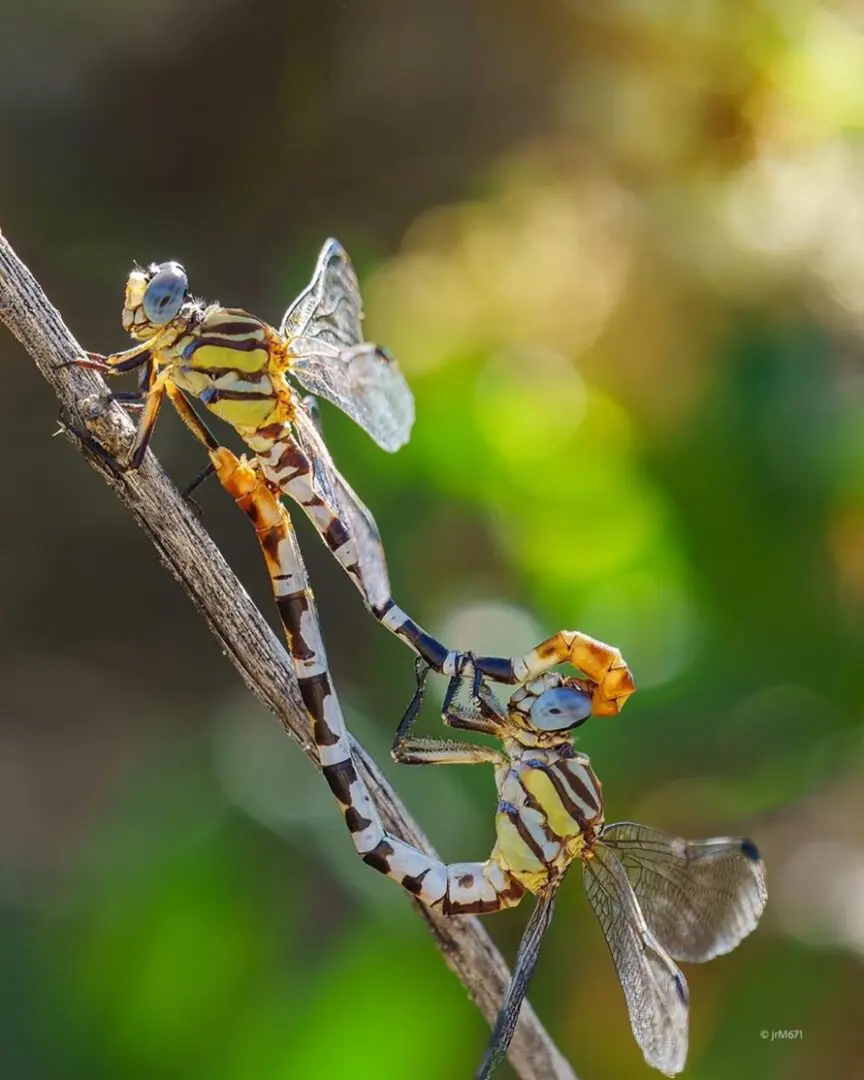The White-belted Ringtail Dragonfly (Mating Pair)

THE “BIRDS AND THE BEES”… AND THE DRAGONFLIES ON TREES?
These beautiful, white-banded ringtail dragonflies (Erpetogomphus compositus) were photographed at the Pabco Trailhead in Clark County Wetlands Park. And yes, they are mating!
The male is on the left in the photo, and the female on the right. Dragonflies and damselflies mate in formations called “copulation wheels” or “copulation hearts.” Damselfly copulation “hearts” tend to be more heart-shaped than dragonfly “wheels” because of their more slender and very flexible abdomens, but any dragonfly or damselfly copulation looks like a great exercise in flexibility to us humans.
Male dragonflies prepare for mating by transferring sperm “packets” from their primary genitalia (near the end of the abdomen) to the secondary genitalia, located close to the thorax in the second abdominal segment. Transfer complete, off they go to search for a receptive female! When a suitable partner is located, the male holds her head with special “claspers” at the tip of his abdomen.
Then, it is all up to the female. If she is ready to mate and accepts the male’s advances, she swings her abdomen under and around to join her genitalia to his secondary genitalia, and transfers his sperm packets into her own genitalia. There, they are held for later egg fertilization. Mating complete, the two dragonflies separate and fly off, each about his or her other business.
Fertilization of the eggs does not occur until just before they are laid. Unlike some dragonfly species, white-belted ringtail males do not stay near the females or “guard” them during egg-laying to keep other males away. The females simply hover motionless above the water, and lay their eggs by tapping the ends of their abdomens on the surface.
Like all members of the insect order Odonata (dragonflies and damselflies), white-belted ringtail eggs hatch not into adult dragonflies, but into aquatic larvae, called “nymphs” or “naiads.” They spend most of their lives, often years, in this form. Many, like white-belted nymphs, live in burrows dug into soft, sandy substrate at the bottom of ponds. They feed on other aquatic animals, mostly other insect larvae, capturing them with a specialized extendable lower lip. At last they emerge from the water, and transform into the brilliantly colored, flying adults we recognize.
White-Belted ringtails are members of the clubtail family Gomphidae. Notice the “flared” segments at the ends of the dragonflies’ abdomens in our photo, which give the family its name. In White-Belted Ringtails, the “clubs” appear to have been dipped in gold paint! Though they are alert and fast-flying, clubtail species are often relatively rare and local. They fly low and tend to spend much of their time at rest, perching on sandbars near streams or on vegetation in shady, protected areas. Their multi-colored “camouflage” makes them hard to see. They just don’t “catch the eye” like the aerial darners or bright-colored skimmers!
On Wetlands Park trails during their April to November flight season, look carefully for white-belted ringtails among the Park’s many beautiful dragonflies. If you see one (or more), take a minute to watch if you can, and find out what the dragonfly is “up to.” Though clubtail dragonflies are a group of great interest to many dragonfly enthusiasts, their behavior is very poorly known. You may actually see something previously unrecorded!
- -By Chris Leavitt, President; photo by JR Manuel
Please enjoy these YouTube videos (None are of White-Belted Ringtails, but show similar behaviors). The animated one is just for fun!
Dragonfly life cycle Ilse Knatz Ortabasi 3:31
Dragonfly Nymph underwater Wim Spronk 2:41
Dragonflies Mating at Saltholme RSPB(1) 1:12
Dragonfly life cycle Life For Beginners 1:50
